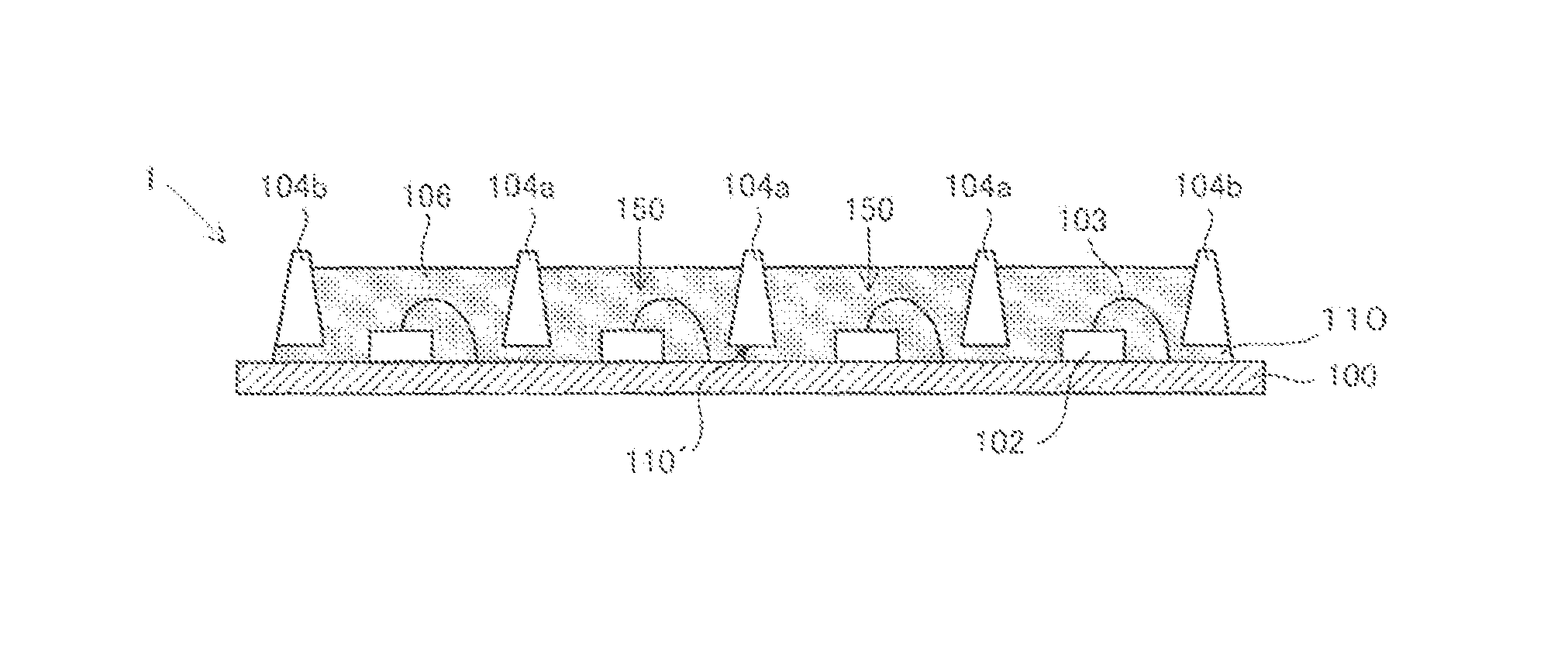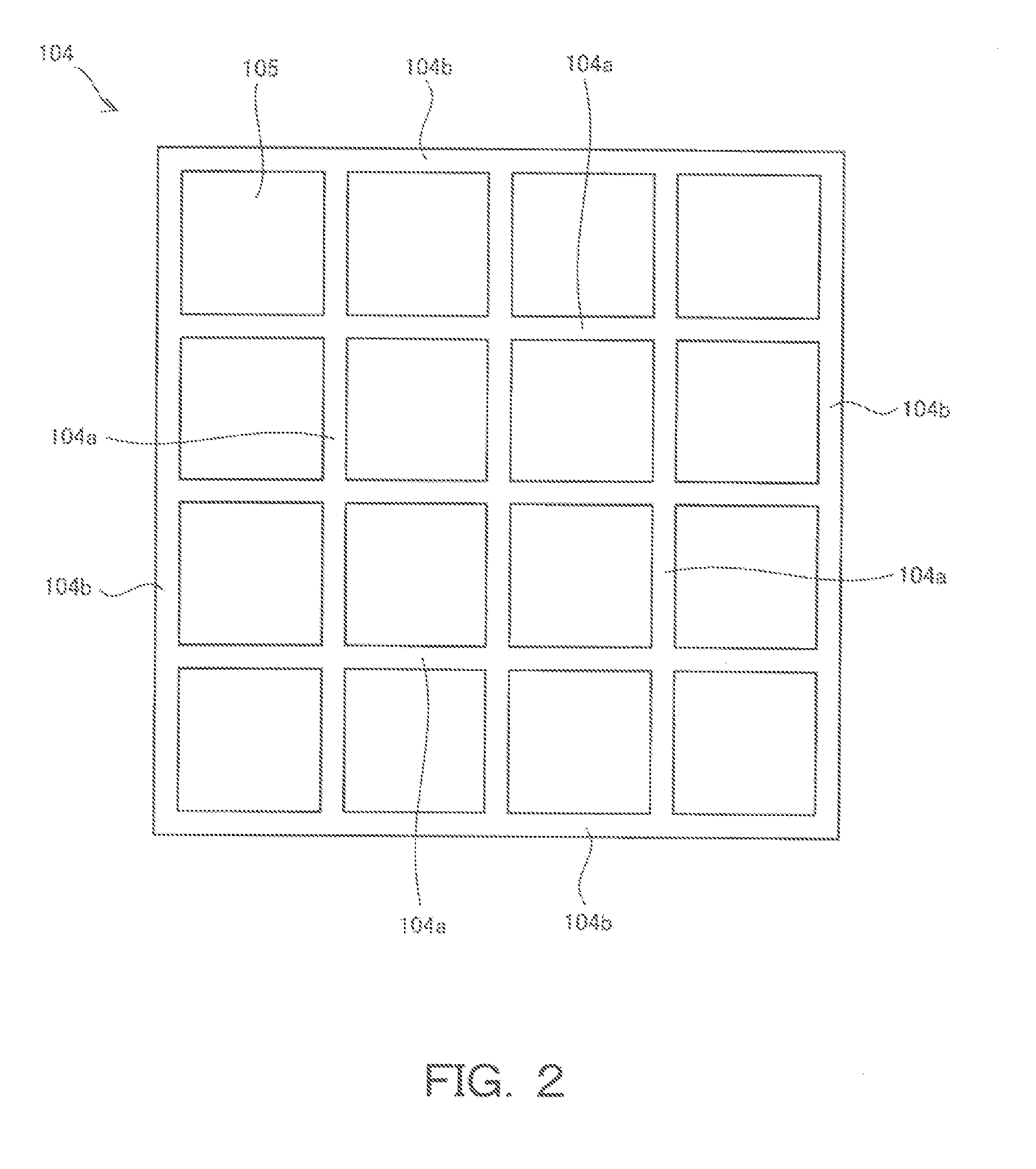Light emitting device and manufacturing method thereof
a technology of light emitting devices and manufacturing methods, which is applied in the direction of semiconductor devices for light sources, lighting and heating apparatus, planar light sources, etc., can solve the problems of air confined between the reflector and the substrate, the terms of light distribution design, and the reliability of the light emitting device. to achieve the effect of reducing production costs and improving reliability
- Summary
- Abstract
- Description
- Claims
- Application Information
AI Technical Summary
Benefits of technology
Problems solved by technology
Method used
Image
Examples
first embodiment
[0034]FIG. 1A is a top view showing the configuration of a light emitting device 1 according to a first embodiment of the present invention, and FIG. 1B is a cross-sectional view taken along line 1B-1B of FIG. 1A.
[0035]A substrate 100 is made of, e.g., glass epoxy resin or the like, and conductor lines (not shown) are formed on a surface of the substrate to feed power to a plurality of LED chips 102. For example, where the light emitting device 1 is used in application to a planar light source or a linear light source, a wiring pattern of conductor lines is formed to connect the LED chips 102 in series, in parallel, or in a combination of series and parallel. Note that the substrate 100 may be a metal substrate or a ceramic substrate instead of the resin substrate.
[0036]The plurality of LED chips 102 are fixed by a resin-based adhesive, solder, or the like at predetermined positions on the substrate 100. The LED chips 102 are arranged in rows and columns on the substrate 100. Each o...
second embodiment
[0056]FIG. 7 is a cross-sectional view showing the configuration of a light emitting device 2 according to a second embodiment of the present invention. In order to prevent resin leakage mentioned above, the light emitting device 2 differs from the light emitting device 1 according to the first embodiment in that the width d1 of the space 110b between the outer edge portion 104b of the reflector 104 and the substrate 100 is smaller than the width d2 of the spaces 110a between the partition wall portion 104a, i.e. the other portion than the outer edge portion 104b, of the reflector 104 and the substrate (d12). As such, by making the width of the space 110b located at the outermost circumference of the light emitting device 2 smaller than the width of the spaces 110a located on the inner circumference side, resin leakage can be prevented while obtaining the fluidity of the encapsulating resin 106 inward of the outer edge portion 104b. The widths d1 and d2 of the spaces should be set a...
third embodiment
[0057]FIG. 8 is a cross-sectional view showing the configuration of a light emitting device 3 according to a third embodiment of the present invention. In order to prevent resin leakage mentioned above, the light emitting device 3 differs from the light emitting device 1 according to the first embodiment in that the reflector 104 directly contacts the substrate 100 at the outer edge portion 104b, not via encapsulating resin. In other words, there is no space between the outer edge portion 104b of the reflector 104 and the substrate 100. The partition wall portion 104a, i.e. the other portion than the outer edge portion 104b, of the reflector 104 is apart from the substrate 100 as in the light emitting device 1 according to the first embodiment, and the space between them is filled with the encapsulating resin 106. With this configuration, resin leakage can be prevented while obtaining the fluidity of the encapsulating resin 106 inward of the outer edge portion 104b. Also, with this ...
PUM
 Login to View More
Login to View More Abstract
Description
Claims
Application Information
 Login to View More
Login to View More - R&D
- Intellectual Property
- Life Sciences
- Materials
- Tech Scout
- Unparalleled Data Quality
- Higher Quality Content
- 60% Fewer Hallucinations
Browse by: Latest US Patents, China's latest patents, Technical Efficacy Thesaurus, Application Domain, Technology Topic, Popular Technical Reports.
© 2025 PatSnap. All rights reserved.Legal|Privacy policy|Modern Slavery Act Transparency Statement|Sitemap|About US| Contact US: help@patsnap.com



